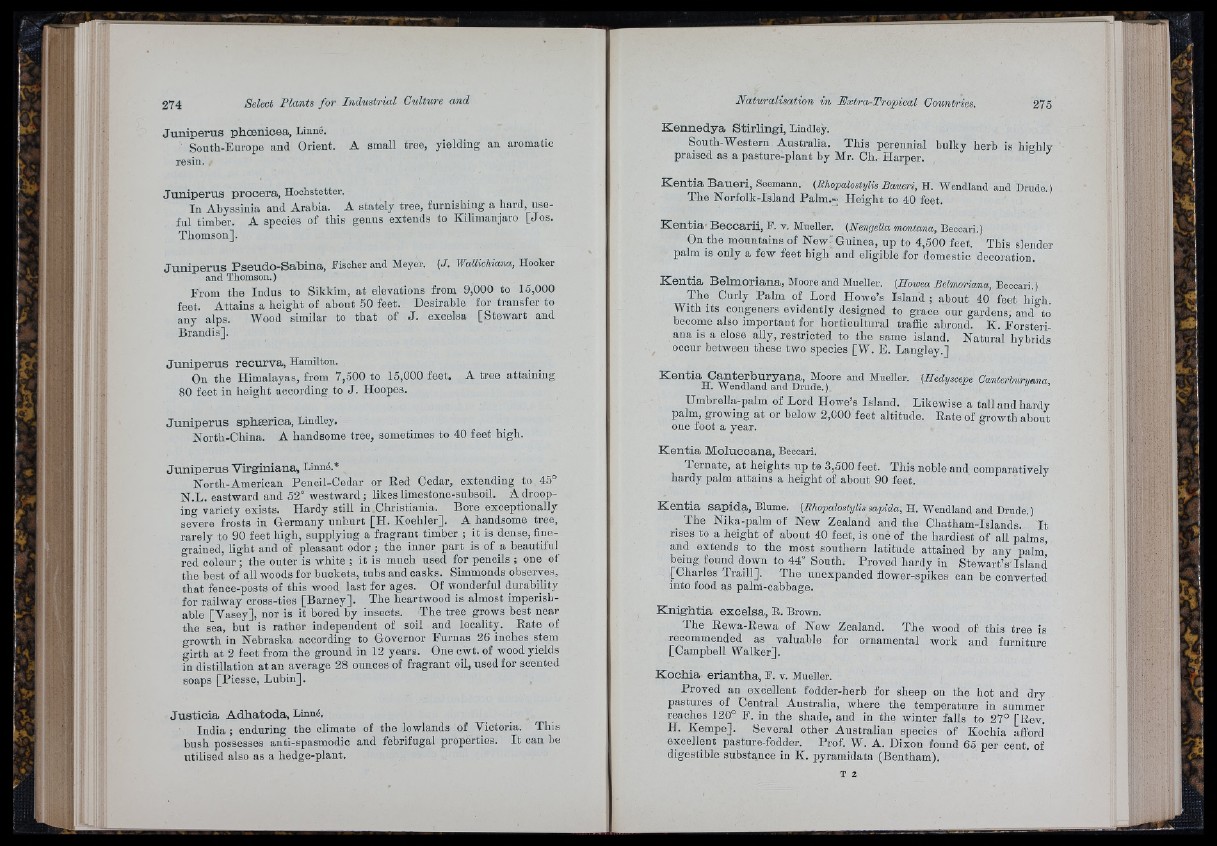
J u n ip e ru s phoenicea, Linné.
South-Europe and Orient. A small tree, yielding an aromatic
resin.
J u n ip e ru s p ro c e ra , Hochstetter.
In Abyssinia and Arabia. A stately tree, furnishing a hard, useful
timber. A species of this genus extends to Kilimanjaro [Jos.
Thomson].
J u n ip e r u s P s e u d o -S a b in a , Fischer and Meyer. (J. Wallichiana, Hooker
and Thomson.)
From the Indus to Sikkim, a t elevations from 9,000 to 15,000
feet. Attains a height of about 50 feet. Desirable for transfer to
any alps. Wood similar to th a t of J . excelsa [Stewart aud
Brandis].
J u n ip e r u s re c u rv a , Hamilton.
On the Himalayas, from 7,500 to 15,000 feet.
80 feet in height according to J . Hoopes.
A tree attaining
J u n ip e r u s sp hæ rio a , Lindley.
North-China. A handsome tree, sometimes to 40 feet high.
J u n ip e r u s V irg in ia n a , Linné.*
North-American Pencil-Cedar or Red Cedar, extending to 45°
N.L. eastward and 52° westward; likes limestone-suhsoil. A drooping
variety exists. Hardy still in Christiania. Bore exceptionally
severe frosts in Germany unhurt [H . Koehler]. A handsome tree,
rarely to 90 feet high, supplying a fragrant timber ; it is dense, finegrained,
light and of pleasant odor ; the inner part is of a beautiful
red colour; the outer is white ; it is much used for pencils ; one of
the best of all woods for buckets, tubs and casks. Simmonds observes,
th a t fence-posts of this wood last for ages. Cf wonderful durability
for railway cross-ties [Barney]. The heartwood is almost imperisli-
able [Vasey], nor is it bored by insects. The tree grows best near
the sea, but is rather independent of soil and locality. Rate of
growth in Nebraska according to Governor Furnas 26 inches stem
girth at 2 feet from the ground in 12 years. Cne cwt. of wood yields
in distillation at an average 28 ounces of fragrant oil, used for scented
soaps [Piesse, Lubin].
J u s tic i a A d h a to d a , Linné.
This
India ; enduring the climate of the lowlands of Victoria,
bush possesses anti-spasmodic and febrifugal properties. I t can
vrtilised also as a hedge-plant.
K e n n e d y a S tirlin g i, Lindley.
South-Western Australia. This perennial bulky herb is highly
praised as a pasture-plant by Mr. Ch. Harper.
K e n tia B a u e ri, Seemann. (ShopcUostylis Baueri, H. Wendland aud Drude.)
The Norfolk-Island Palm.~ Height to 40 feet.
K e n tia B e co a rii, F. v. Mueller. (Nengella montana, Beocari.)
Cn the mountains of New" Guinea, up to 4,500 feet. This slender
palm is only a few feet high and eligible for domestic decoration.
K e n t ia B e lm o ria n a , Moore and Mueller. (Howea Belmoriana, Beocari.)
The Curly Palm of Lord Howe’s Island ; about 40 feet high.
With its congeners evidently designed to grace our gardens, and to
become also important for horticultural traffic abroad. K. Forsteri-
ana is a close ally, restricted to the same island. Natural hybrids
occur between these two species [W. E. Langley.]
K e n tia C a n te rb u ry a im , Moore and Mueller. [Hedyscepe Canterburymia
H. Wendland and Drude.)
Umbrella-palm of Lord Howe’s Island. Likewise a tall and hardy
palm, growing a t or below 2,000 feet altitude. Rate of growth about
one foot a year.
K e n tia M o lu co an a , Beocari.
le rn a te , at heights up to 3,500 feet. This noble and comparatively
hardy palm attains a height of about 90 feet.
K e n tia s a p id a , Blume. (Rhopatostylis sapida, H. Wendland and Drude.)
^ The Nika-palm of New Zealand and the Chatham-Islands. I t
rises to a height of about 40 feet, is one of the hardiest of all palms,
and extends to the most southern latitude attained by any palm’
being found down to 44° South. Proved hardy in Stewart’s Island
[Charles Traill]. The miexpanded flower-spikes can be converted
into food as palm-cabbage.
K n ig -h tia e x c e ls a , R. Brown.
The Eewa-Rewa of New Zealand. The wood of this tree is
recommended as valuable for ornamental work and furniture
[Campbell Walker].
K o o h ia e r ia n th a , F. v. Mueller.
Proved an excellent fodder-herb for sheep on the hot and dry
pastures of Central Australia, where the temperature in summer
reaches 120° F. in the shade, and in the winter falls to 27° [Rev.
H. Kempe]. Several other Australian species of Koohia afford
excellent pasture-fodder. Prof. W. A. Dixon found 65 per cent, of
digestible substance in K. pyramidata (Bentham).
tipi I